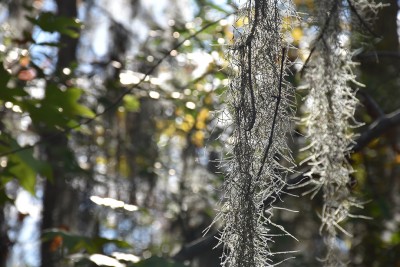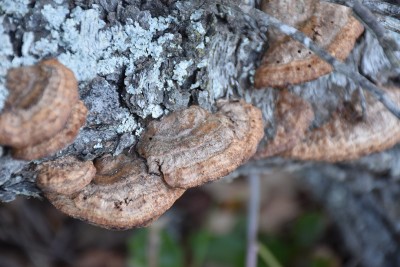In November, I and 12 other Shaver’s Creek staff attended the 2015 conference for the National Association for Interpretation. As I’ve been telling friends and family about this event, their responses have consistently begun with one question: What is interpretation?
The National Association for Interpretation (NAI) describes an interpreter as someone who helps visitors to learn about a place that is of value to the interpreter. Currently, my understanding of an interpreter is someone who explains the meaning of a resource to the general public. Interpreters can be costumed characters at a historical monument, naturalists at a nature center who lead explorative hikes, or volunteers at a zoo who converse with visitors about animals and exhibits.

Spanish moss at First Landing State Park
What, then, happens at the NAI national conference and why did 13 people from Shaver’s Creek attend? This year, more than 600 interpreters attended the annual conference in Virginia Beach, with representatives from nature centers, zoos, historical monuments, parks departments, and museums. The conference spanned five days and featured field trips to local parks, an aquarium visit, and regional meetings; however, the core of the conference was its 90 workshops offered over the course of three days. The workshops were created and led by directors, interpreters, and educators from around the country, and encompassed a wide variety of topics. Instead of trying to explain the essence of the workshops myself, I asked the Shaver’s Creek staff who attended the conference to give a brief description of their favorite workshop. I’ve split their responses into four categories: Interpretation, Experiential Learning, Storytelling, and Natural History.

“In my favorite session there were four ‘characters’ (Enos Mills’ wife, Freeman Tilden, a social science/communication theorist, and a brain researcher) all debating about their perspective on how to define ‘meanings,’ how people create meanings, how interpreters can relate content to visitors, and techniques to facilitate meaning-making.”
– Lucy McClain, Graduate Assistant
“My favorite workshop had me think about what I thought interpretation meant and how visitors retain information. As an interpreter you do not always have a chance to see if your audience will remember what you shared with them. Listening to Brian Forist list the most useful strategies and connect them with visitor interviews, months after they visited an interpretive site, helped show how certain techniques work and others do not.”
– Lindsay McAfee, Environmental Education Intern
“One of my favorite workshops was ‘Interpretation versus visitor experience: Is there a meaningful difference?‘ as it provokes thought on our current visitor service practices. I enjoyed the national workshop as it allows professionals from across the country to share ideas on programs, management issues and current trends.”
– Doug Wentzel, Program Director and Naturalist

Birding at Virginia Beach between sessions.
“One of my most rewarding experiences was attending the ‘Interpretive Media Section’ meeting. I hadn’t realized the group existed within NAI, and was pleasantly surprised to find a room full of designers and disseminators of interpretive materials who were excited about sharing best practices and collaborating through social media.”
– Joshua Potter, Marketing Information Coordinator

“We began my favorite session by receiving live Bess Beetles to observe, ask questions and discuss the natural history of these creatures in small groups. Feeling the beetle crawl over my hand, listening to it hiss and seeing the tiny hairs on it’s legs through a hand lens reminded me that I’d like my teaching to be more about facilitating discovery than imparting facts or wisdom.”
– Kristen Balschunat, Program Assistant

First-person interpretation at Colonial Williamsburg

“’Through stories and narratives, you’re sharing backhandedly facts and tidbits of knowledge.’ Doug Elliot, storyteller from North Carolina, had the largest impact on me at the national conference. His use of genuine humor, natural history facts, and music within his workshops has re-inspired my own passion for storytelling and for incorporating natural history folklore into my own programs.”
– Torri Helene, Environmental Education Intern
“I attended the storytelling workshop with Susan Strauss. I look forward to using her techniques for engaging audiences around the campfires next summer.”
– Kate Berardi, School Programs and Summer Camp Director
“I think one of my favorite workshops was one centered all about zoos and aquariums. We discussed the importance of sharing the story of each of our animals. If we can connect people to the story of an individual animal, we can help to inspire them to protect their entire species!”
– Joe Seebode, Environmental Education Intern

“I especially enjoyed a workshop that focused on mushrooms. We learned about how mushrooms grow and the basics of how to identify them. Leaving the workshop, I felt empowered and knowledgeable enough to lead a public program on mushrooms at Shaver’s Creek.”
– Alexa Sarussi, Environmental Education Intern

“One of the most inspiring workshops I attended talked about the potentially catastrophic geology of the Pacific Northwest also being what makes the area so amazing. When approaching potentially scary or intimidating topics it can be easy to teach it with fear as the underlying message, but framing things positively can lead people into appreciation and action more effectively.”
– Andy Hayes, Environmental Education Intern
As you can see, many parts of Shaver’s Creek were represented at the conference, from interns to program directors to marketing coordinators. Whether it was a workshop about natural history folklore or the life cycle of mushrooms, it seems that everyone left the conference with many new ideas and much inspiration to continue improving what we do at Shaver’s Creek. Hopefully this post leaves you with a better understanding of the vast meaning of interpretation. If you are especially intrigued and would like to experience it for yourself, simply head over to Shaver’s Creek!




